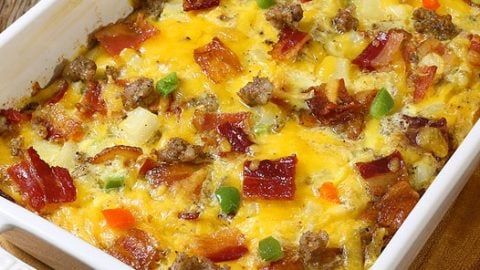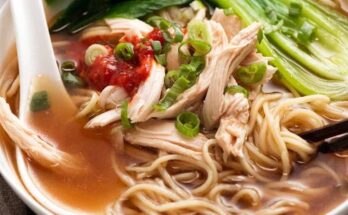Breakfast Egg Casserole Recipe: There’s something truly comforting about a hot, hearty breakfast. And when it comes to fueling your day right, few dishes hit the spot like a breakfast egg casserole. This classic dish is the ultimate morning crowd-pleaser, combining the fluffy goodness of scrambled eggs with a medley of meats, vegetables, and cheeses baked into one delicious pan. It’s ideal for feeding a family, prepping for a busy week, or serving a hungry brunch crowd.
One of the best things about breakfast egg casserole is its versatility. Whether you’re a meat lover, a vegetarian, or somewhere in between, there’s a variation for everyone. From bacon and sausage to bell peppers and spinach, you can customize it to suit your tastes and dietary preferences. Plus, you can prepare it the night before and just pop it in the oven in the morning. It’s convenience and flavor wrapped into one.
Nutritional Benefits of Egg Casserole
This isn’t just a tasty treat—it’s a protein-packed, energy-boosting way to start your day. Eggs are loaded with essential nutrients like vitamin D, B12, and choline. When combined with fresh veggies and lean meats, you’re getting a balanced meal with a great mix of protein, healthy fats, and carbs. It’s also gluten-free (depending on your ingredients), making it friendly for those with dietary restrictions.
Ingredients You’ll Need
Core Ingredients
To make a classic breakfast egg casserole, you’ll need the following staples:
- 12 large eggs – the base of your casserole
- 1 cup milk or heavy cream – adds creaminess
- 2 cups shredded cheese – cheddar, mozzarella, or your choice
- 1 pound sausage or bacon – for a savory, meaty punch
- 2 cups chopped vegetables – like bell peppers, onions, and spinach
- Salt and pepper to taste
These ingredients create a solid base. From here, you can customize as much as you like.
Optional Add-Ins for Extra Flavor
Want to kick your casserole up a notch? Try these add-ins:
- Chopped jalapeños – for a spicy kick
- Mushrooms – adds umami and texture
- Diced tomatoes – for a juicy, fresh flavor
- Green onions or chives – for garnish
- Hash browns or cubed bread – for a heartier dish
Mix and match based on what’s in your fridge or what you’re craving.
Kitchen Tools and Equipment
Must-Have Tools
Here’s what you need to get started:
- Mixing bowls – for whisking eggs and combining ingredients
- Whisk or fork – to beat the eggs
- Skillet – for cooking meats and vegetables
- 9×13-inch baking dish – standard size for casseroles
- Oven – of course!
Helpful Extras
Some bonus tools that can make life easier:
- Non-stick spray – keeps your casserole from sticking
- Cutting board and sharp knife – for prep
- Spatula or serving spoon – for dishing it out
- Food thermometer – to ensure it’s fully cooked (target 160°F)
Having everything prepped and ready helps streamline the process and avoid kitchen chaos.
Preparing Your Ingredients
Prepping the Veggies and Meats
Start by washing and chopping your vegetables into small, uniform pieces. This helps them cook evenly and blend well into the casserole. If you’re using sausage or bacon, cook them in a skillet until they’re browned and fully done. Drain any excess fat—especially from bacon—to avoid making your casserole greasy.
You can sauté your vegetables in the same skillet with a little olive oil or butter. This enhances their flavor and softens them slightly before baking. Don’t overcook them—they’ll finish cooking in the oven.
Cracking and Beating the Eggs
In a large bowl, crack all 12 eggs and whisk them until smooth. Add in your milk or cream, then season with a pinch of salt and pepper. The milk gives the casserole a creamy texture and prevents it from becoming rubbery. For extra flavor, you can also toss in a bit of garlic powder, onion powder, or dried herbs.
Make sure your eggs are well beaten and mixed thoroughly with the dairy. This creates a smooth, custard-like consistency that binds the whole casserole together.
Step-by-Step Cooking Instructions
Step 1: Preheat the Oven
Start by preheating your oven to 375°F (190°C). This ensures even cooking from the get-go. Grease your baking dish with non-stick spray or a thin layer of butter to prevent sticking.
Step 2: Cook the Meat and Veggies
Brown your sausage or bacon in a skillet. Once it’s cooked, remove it and let it drain on paper towels. In the same skillet, sauté your chopped vegetables for 4–5 minutes until just tender.
Step 3: Whisk the Eggs and Dairy
In your large mixing bowl, beat the eggs with milk, salt, and pepper. Add in any spices you prefer. Stir in half of your shredded cheese into the egg mixture for extra gooeyness.
Step 4: Layer and Combine Ingredients
Now the fun part! Spread your cooked meat evenly in the bottom of your baking dish. Next, layer on the sautéed vegetables. Pour the egg mixture over the top, ensuring everything is evenly covered. Sprinkle the remaining cheese over the surface for that golden, bubbly topping.
Step 5: Bake to Perfection
Slide the casserole into your preheated oven and bake for 35–45 minutes. It’s done when the top is golden brown and a knife inserted in the center comes out clean. Let it rest for 5–10 minutes before slicing.
Serving Suggestions
Best Ways to Serve Breakfast Egg Casserole
Once your egg casserole is hot and fresh out of the oven, the serving possibilities are endless. Cut it into square portions for a neat, tidy presentation. It pairs beautifully with a fresh side salad, fruit platter, or some toasted bread for a complete breakfast spread.
If you’re feeding a crowd, consider setting up a mini buffet. Offer toppings like salsa, sour cream, avocado slices, or hot sauce so guests can customize their servings. Want to make it even more special? Serve it alongside fresh-squeezed orange juice or a warm cup of coffee.
For a brunch gathering, you can even plate it with a side of crispy hash browns or roasted potatoes. The balance of soft eggs and crunchy sides makes for a delightful texture contrast. And don’t forget to garnish with chopped herbs or a sprinkle of extra cheese right before serving—it elevates the whole experience.
Storing and Reheating Leftovers
One of the best things about egg casserole? It reheats like a dream. Store any leftovers in an airtight container in the fridge for up to 4 days. When you’re ready to enjoy it again, simply microwave individual portions for 1-2 minutes or reheat the whole dish in the oven at 350°F (175°C) for 10-15 minutes.
If you’re planning ahead, you can even freeze it. Wrap tightly in plastic wrap and foil, or use freezer-safe containers. When you’re ready, let it thaw in the fridge overnight, then bake until heated through.
Tips for the Perfect Egg Casserole Every Time
Get the Texture Just Right
One of the trickiest parts of making a breakfast casserole is avoiding a rubbery texture. The secret? Don’t overbake it. Start checking for doneness around the 35-minute mark. If the center jiggles slightly but is firm to the touch, it’s ready. Overbaking causes the eggs to dry out and become tough.
Also, avoid adding too much dairy. A good rule of thumb is about 1/4 cup of milk or cream per 3 eggs. This ratio keeps the casserole creamy without making it soggy.
Flavor It Like a Pro
Don’t be afraid to experiment with spices and herbs. Try adding paprika, cayenne pepper, Italian seasoning, or fresh thyme. A little seasoning goes a long way in boosting flavor.
You can also mix in different cheeses—sharp cheddar for boldness, mozzarella for stretch, or feta for tang. Want a touch of luxury? Try gruyère or smoked gouda.
Making It Ahead of Time
Overnight Casserole Option
Need a stress-free morning? Prep your casserole the night before. Follow all the steps up to the baking stage. Cover tightly with plastic wrap or foil and refrigerate overnight. In the morning, just pop it in a preheated oven and bake as directed—maybe just a few extra minutes since it’ll be cold to start.
This make-ahead option is perfect for holiday mornings, weekend brunches, or busy weekdays when you want a homemade meal without the morning hustle.
Variations to Try
Vegetarian Breakfast Egg Casserole
Skip the meat and load up on veggies for a vegetarian-friendly option. Try combinations like spinach, mushrooms, tomatoes, zucchini, and onions. Add feta cheese for a Mediterranean flair, or sprinkle with nutritional yeast for a dairy-free cheese flavor.
Low-Carb and Keto Versions
Looking for a keto-friendly option? Ditch the starchy add-ins like bread or potatoes. Use full-fat dairy and load up on low-carb veggies like bell peppers, spinach, and broccoli. Adding meats like bacon, sausage, or ham keeps it hearty and satisfying without the carbs.
Meat-Lover’s Breakfast Casserole
For those who want something ultra hearty, go big with sausage, bacon, and even chopped ham. You can layer different types of meats throughout or mix them into the egg batter for an even distribution. Add pepper jack cheese for a spicy kick.
FAQs about Breakfast Egg Casserole Recipe
Q1: Can I make breakfast egg casserole ahead of time?
Yes! This recipe is perfect for meal prep. You can assemble the casserole the night before, refrigerate it, and simply bake it the next morning.
Q2: How long does breakfast casserole last in the fridge?
Properly stored in an airtight container, it will last up to 4 days in the refrigerator. Just reheat in the oven or microwave before serving.
Q3: Can I freeze egg casserole?
Absolutely. Let it cool completely, wrap tightly with foil or plastic wrap, and freeze for up to 2 months. Thaw overnight in the fridge before reheating.
Q4: What’s the best cheese for egg casserole?
Cheddar, mozzarella, and Swiss are all great options. You can also mix cheeses for extra flavor.
Q5: Can I add meat or vegetables?
Yes! Customize it with cooked bacon, sausage, ham, bell peppers, spinach, mushrooms, or onions for a heartier dish.
Q6: Why is my egg casserole watery?
Too many watery vegetables (like tomatoes or zucchini) can cause this. Make sure to sauté or drain veggies before adding them to the mix.
Q7: Can I make it dairy-free?
Yes. Use plant-based milk and dairy-free cheese to make a delicious dairy-free version.
Conclusion
A breakfast egg casserole is more than just a meal—it’s a time-saving, flavor-packed, and endlessly customizable dish that brings people together. Whether you’re cooking for your family, meal-prepping for the week, or hosting a brunch, this dish delivers every time. With the flexibility to cater to all diets and tastes, plus the ability to prep ahead, there’s really no reason not to add this classic to your regular recipe rotation.
So the next time you’re wondering what to cook on a lazy Sunday or for your next big gathering, remember: the breakfast egg casserole has your back.



